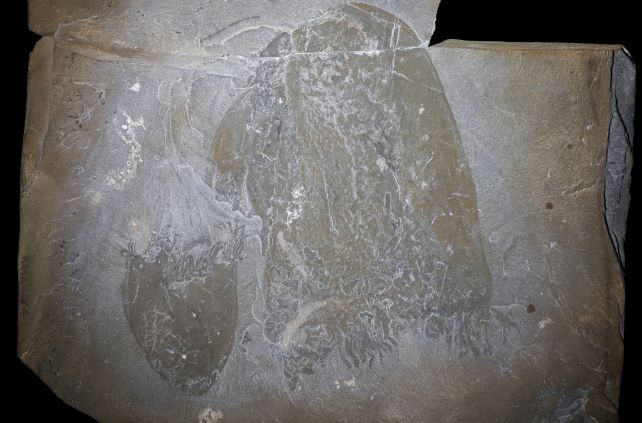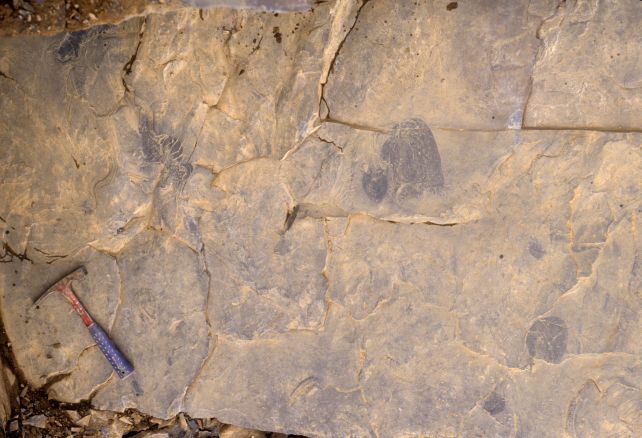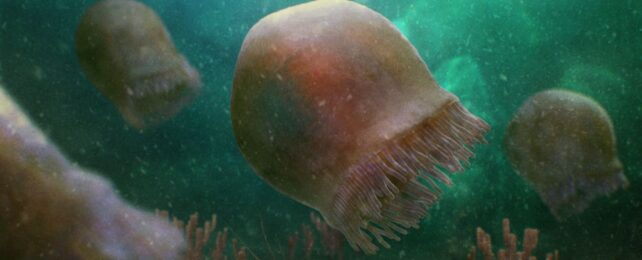Something truly and wonderfully special has been found in a 505-million-year-old Canadian fossil bed.
There, preserved in the especially fine silt of a lagerstätte, paleontologists found more than 170 exquisite fossils of ancient jellyfish that swam Earth's waters hundreds of millions of years before the first dinosaurs trod its soil.
The find is incredible because soft tissues are so rarely preserved in the fossil record, and these are so beautifully immortalized that even anatomical details, like their little jelly tentacles, are visible. And the newly discovered species, Burgessomedusa phasmiformis, now represents the earliest known jellyfish on the planet.
"Although jellyfish and their relatives are thought to be one of the earliest animal groups to have evolved, they have been remarkably hard to pin down in the Cambrian fossil record," says paleontologist Joe Moysiuk of the University of Toronto and Royal Ontario Museum in Canada.
"This discovery leaves no doubt they were swimming about at that time."

Most of the fossil record we have consists of hard bony bits that are better able to survive the various fossilization processes. Soft tissue is much more delicate and degrades more quickly, so the records of it are few. If it will be retained at all, a type of fossil bed called a lagerstätte is the place to look.
The Burgess Shale in Canada is a famous lagerstätte that has preserved many soft animals from the Cambrian period. It was once the bed of a body of water; animals that lived therein fell into the fine silt, where time and pressure worked their long magics to preserve them, often soft tissue and all.
Jellyfish, belonging to the phylum Cnidaria, are very soft tissue, so we don't expect them to be preserved all that often, if at all. Cnidarian preservation is not unknown, though. Cnidarians of the polyp variety – those that are anchored to rocks – have been found in fossil beds dating up to 560 million years ago.
Polyps are the early life stage of modern jellies, but there are some polyps that remain polyps. Scientists believe that, evolutionarily, polyps came first and later transitioned into free-swimming creatures – Cnidarians of the medusa variety, otherwise known as jellyfish.

But the absence of medusae in the fossil record made this change difficult to characterize. There were some previous fossils thought to be jellyfish, but they were later classified as comb jellies, belonging to a different phylum entirely, Ctenophora.
The discovery of Burgessomedusa gives us a new baseline for calculating the timeline of jellyfish evolution. And it drives home the diversity of Cambrian marine ecosystems, which have the appearance of domination by hard-shelled creatures, as those are more readily preserved as fossils. Instead, they would have been rich and complex, with a range of squishy predators, too.
"Finding such incredibly delicate animals preserved in rock layers on top of these mountains is such a wondrous discovery," says paleontologist Jean-Bernard Caron of the Royal Ontario Museum.
"Burgessomedusa adds to the complexity of Cambrian food webs, and like Anomalocaris, which lived in the same environment, these jellyfish were efficient swimming predators. This adds yet another remarkable lineage of animals that the Burgess Shale has preserved, chronicling the evolution of life on Earth."
The research has been published in the Proceedings of the Royal Society B Biological Sciences.
